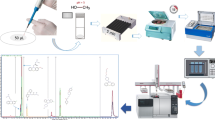Abstract
Twenty epileptic children taking phenobarbital (PB) were evaluated for the concentration of PB in their saliva (Sa), total serum concentration (TS), free serum concentration (FS), and also the pH of the saliva samples. The Sa/TS ratio was 43.0±5.2% (mean±SD), and showed a close relationship between the two (r=0.98). The free serum concentrations for PB were also observed to be closely correlated to the saliva concentration (r=0.99), as well as to the total serum concentration, with the FS/TS ratio being 45.0±5.6%. However, no obvious relationship between the salivary pH and the Sa/TS ratio for PB was observed. This suggested the usefulness of monitoring the PB saliva concentrations in clinical management of epilepsy.
Similar content being viewed by others
Abbreviations
- FS:
-
free serum concentration of phenobarbital
- PB:
-
phenobarbital
- Sa:
-
saliva concentration of phenobarbital
- TS:
-
total serum concentration of phenobarbital
References
Bartels H, Oldigs HD, Günther E (1977) Use of saliva in monitoring carbamazepine medication in epileptic children. Eur J Pediatr 126:37–44
Friedman IM, Litt IF, Henson R, Holtzman D, Halverson D (1981) Saliva phenobarbital and phenytoin concentrations in epileptic adolescents. J Pediatr 98:645–647
Fung KC, Ueda K (1982) Saliva and serum valproic acid levels in epileptic children. J Pediatr 100:512
Johnston MV, Freeman JM (1981) Pharmacologic advances in seizure control. Pediatr Clin North Am 28:179–194
Kutt H, Penny JK (1974) Usefulness of blood levels of antiepileptic drugs. Arch Neurol 31:283–288
McAuliffe JJ, Sherwin AL, Leppik IE, Fayle SA, Pippenger CE (1977) Salivary levels of anticonvulsants: a practical approach to drug monitoring. Neurology 27:409–413
Pippenger CE (1980) Rationale and clinical application of therapeutic drug monitoring. Pediatr Clin North Am 27:891–925
Rylance GW (1979) Monitoring saliva anticonvulsant levels in children. Dev Med Child Neurol 21:387–389
Rylance GW, Moreland TA (1981) Saliva carbamazepine and phenytoin level monitoring. Arch Dis Child 56:637–652
Author information
Authors and Affiliations
Rights and permissions
About this article
Cite this article
Tokugawa, K., Ueda, K., Fujito, H. et al. Correlation between the saliva and free serum concentration of phenobarbital in epileptic children. Eur J Pediatr 145, 401–402 (1986). https://doi.org/10.1007/BF00439247
Received:
Accepted:
Issue Date:
DOI: https://doi.org/10.1007/BF00439247




